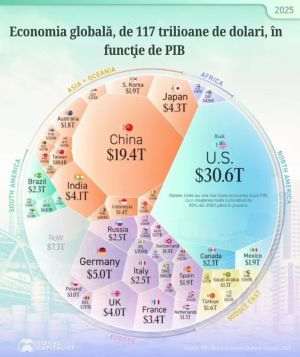The Romanian National Bank has cut the monetary policy, according to the uncommon statement by governor Isărescu from two years ago. In the press, the enthusiasm was moderate, amid the significant reduction expectations concerning the beginning of a new cycle of cuts of the policy rate.
But does the decision of the NBR have any real meaning anymore? Unfortunately, the answer is "no", as the NBR has long lost the control over the interest rates in the real economy, because the speculative excesses have created an acute dependence on the fluctuations of the foreign investments.
The governor of the NBR has pleaded for the necessity of a new agreement of the International Monetary Fund, acknowledging that he "doesn't really know what comes next". The money from the IMF could offset the outflows of private equity, even though the same Mugur Isărescu was the one who was praising the benefits of the signing of the agreement concluded with the IMF not too long ago.
Could these statements mean that not even the National Bank of Romania believes in the stimulating power of the low interest rates? And where do these radical changes in the position of the NBR officials come from, more volatile even than the fluctuations of the leu itself? Could this be an acknowledgment of the fact that one dollar from the IMF does not have the same quality (author's note: due to it being a loan) compared to one dollar coming from foreign investments?
The excuses provided for the cut of the policy rate could point towards such a conclusion. The NBR can continue to emphasize the role of the dwindling demand in reducing inflation pressure, but it uses a "broken" gauge of the "temperature" of prices.
According to data in the press release, "the annual CORE2 adjusted inflation rate has continued its downward trend, as it fell to 2.66% in May 2013, compared to 3.25% in the month of December 2012".
But what is the adjusted CORE2 inflation? An inflation without inflation, because the formula does not include managed prices, volatile prices (author's note: such as food and energy), as well as the price of tobacco and alcoholic drinks.
Beyond the excuses without any justification provided by the current economic reality, the National Bank felt compelled to act just to prove its "active "involvement in "resolving" the current economic issues before next year's presidential elections.
Ignoring the delays which appear on the channel which propagates the changes in the policy rate to the real economy, especially in the case of an emerging unrestructured economy, governor Isărescu was quick to state that "the bank's interest rates could fall in summer". Unfortunately, the press conference of the NBR did not provide us with a cohesive and well-grounded justification for this claim, especially since the previous historical low of the interest rate has yet to stimulate anything, more than a year after its implementation.
A lower cut of the financing costs will not have any visible effects on lending, as shown by the experience of our neighbors. Whether we are talking about a policy rate of 4.25% (Hungary), 2 >75% (Poland) or even 0.05% (Czech Republic), lending continues to contract or significantly tempers its growth because of the same reasons: the lack of solvent demand, amid the degradation of the economic outlook and the high weight of non-performing loans in the portfolio of banks.
After all, even an interest rate of zero is too much for a company whose business has entered a downward multi-annual trend, which is true even if its current indebtedness ratio was zero.
But still, why can't the NBR help the economy by cutting the interest rates? Because of the low levels of the non-performing loans and the undercapitalization of the banks and of companies.
Out of the whole region of Central and Eastern Europe, Romania has the highest level of non-performing loans. The ratio of non-performing loans has climbed over 3% in April 2013 over the same period of last year, to 19.46%, and the credit risk ratio has reached 30.03%.
If the banks' balance sheets do not undergo a comprehensive restructuring process, accompanied by the significant increase of capital, the resumption of lending will only remain a pipe dream.
While we can say that the mechanism for propagating the policy rate changes to the real economy is broken, a similar characterization can also be used when it comes to the hope that they will reduce the government's borrowing costs.
The average yields of the government bonds have increased over 6% in June 2013, with the greatest increases being posted for the 3-year maturity (+11.7%), and respectively 5 years (+10.7%). The hike of the interest rates charged by banks on the primary market has caused the failure of the two latest auctions this June, through which the government was trying to raise 600 million lei with a maturity in April 2020, and April 2023, respectively.
Why would the borrowing costs of the state fall, when the overall trend in the last few months, for emerging as well as developed economies, has been for them to rise? Has there been any sign of fiscal responsibility that would give investors in government bonds any hope? On the contrary!
Perhaps these "minor details" could be ignored, provided the crisis in Europe showed a major improvement, but we are still far away from that ideal case.
An OECD analysis in the beginning of the year showed that the additional capital requirements of the major European banks was about 400 billion Euros, and the issue of undercapitalization was not only confined to the countries on the outskirts of the Eurozone.
More recently, Swiss credit risk review company Independent Credit View said that the capital deficit of some of the major banks in Germany, Italy, France, Spain, Italy, Poland, Austria, Holland and Ireland is of about 776 billion Euros, as the stress tests include greater than zero weights for their government bonds in their portfolios.
And the major international banks present in Central and Eastern Europe are trying to bolster their capital, sometimes due to direct pressure from their governments, by abandoning a series of activities in this region and selling off their assets. All of these elements indicate a beginning, not an end of the rising trend of the borrowing costs.
Romania is already faced with major problems when it comes to supporting its investment capacities, amid the massive drop in the foreign investments. Under these circumstances, the conditions must be created for the domestic accumulation of capital, based on domestic saving, a phenomenon which the latest decision of the NBR will affect negatively.
It is sometimes said that the decisions of the central banks are brave, when they announce interest rate cuts, in spite of the weakening of their currencies and of a high and persistent inflation which result from them. Nothing can be further from the truth, because it is all just a way of choosing the easy way out, in the hope of building an alibi with a slight hint of credibility.
In the case of the latest policy decision, the NBR would have shown courage by increasing the policy rate, which would have stimulated saving and started off the rebuilding of the Romanian domestic capital. The chosen path, even though it will bring the "official" interest rate to "zero", will not cause the economy to become healthier, not even its financial sector.
But maybe the National Bank of Romania is merely happy to maintain the illusion of recovery, at least until the beginning of a new electoral cycle starting in 2014.
























































